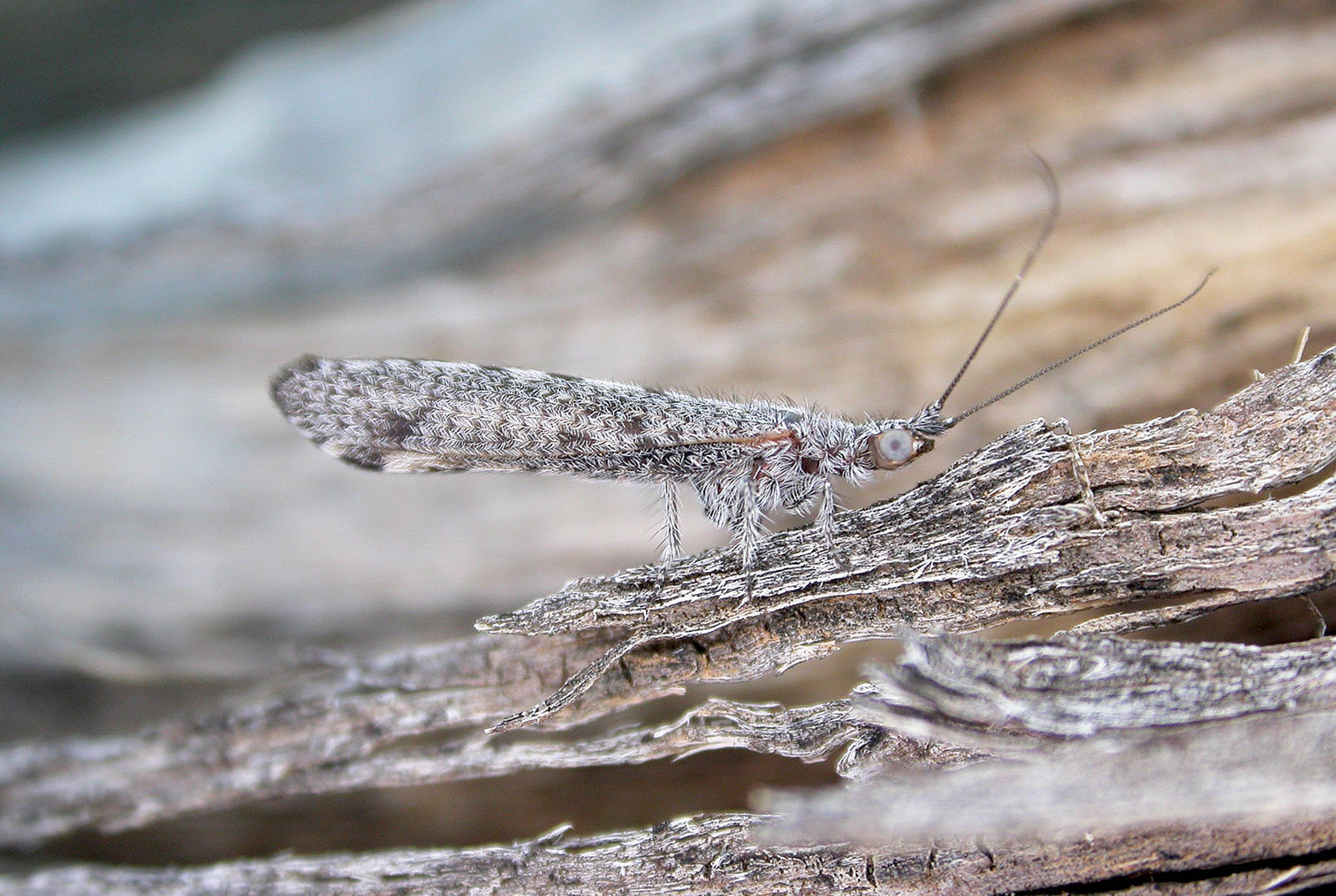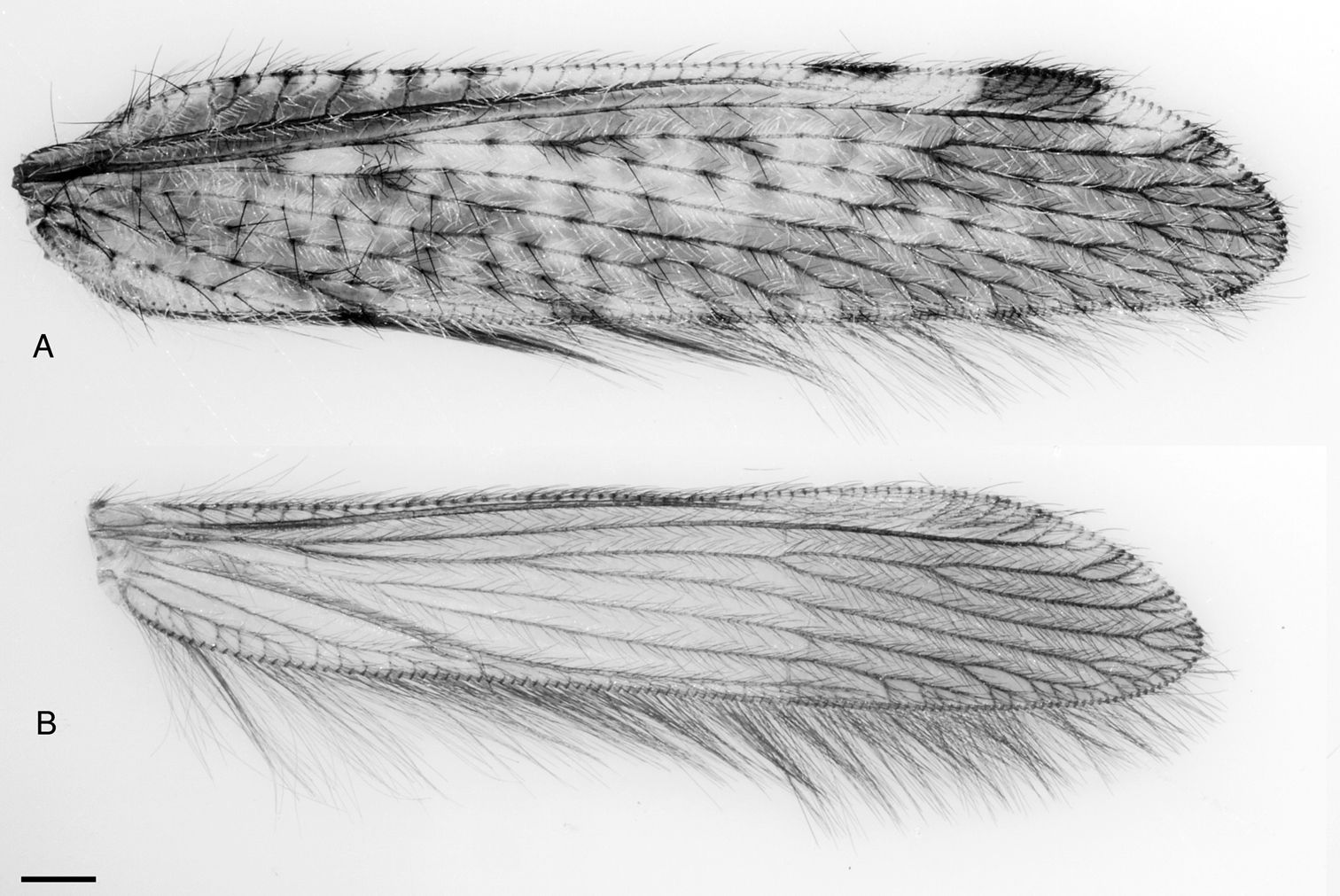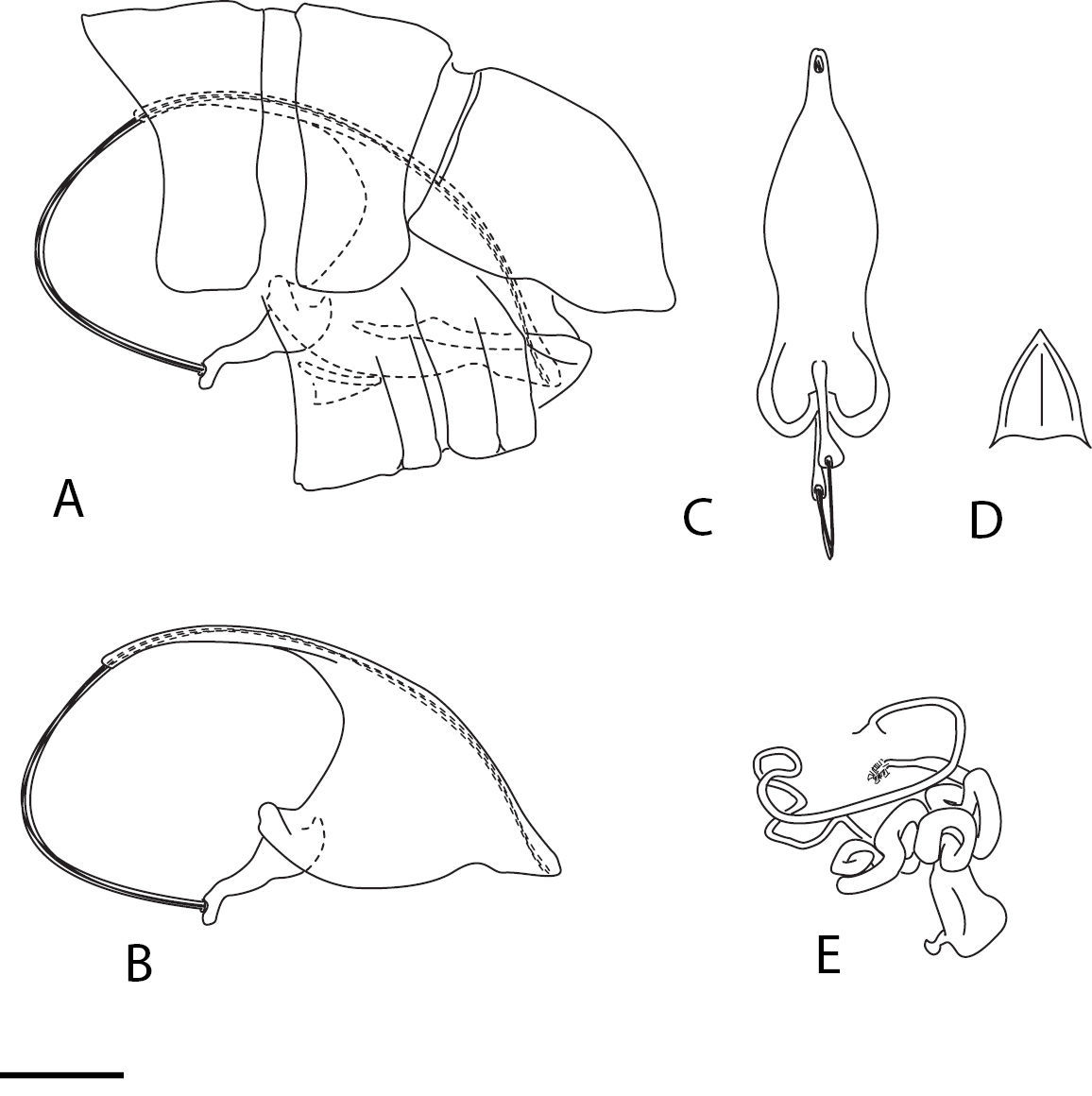






(C) 2010 Shaun L. Winterton. This is an open access article distributed under the terms of the Creative Commons Attribution License, which permits unrestricted use, distribution, and reproduction in any medium, provided the original author and source are credited.
For reference, use of the paginated PDF or printed version of this article is recommended.
Stenobiella variola sp. n., a new species of beaded lacewing (Neuroptera: Berothidae), is described and figured from south-eastern Australia. A preliminary key to Stenobiella species is presented.
Berothidae, Neuroptera, lacewing
Beaded lacewings (Berothidae) are a small family of Neuroptera
comprising approximately 100 species occurring throughout most
biogeographical regions. Members of the family are recognised by
elongation of the pronotum, female usually with hypocaudae and
substantial cubital veins in both wings. The larvae are associated with
termites, and undergo a degree of hypermetamorphosis during development
(
Four subfamilies of Berothidae are recognised: Rhachiberothinae, Cyrenoberothinae, Berothinae and Nosybinae (
Stenobiella Tillyard (Berothinae) is an endemic Australian genus originally described based on two species (Stenobiella hirsutissima Tillyard and Stenobiella gallardi Tillyard) from Queensland and New South Wales (
Genitalia were macerated in 10% KOH at room temperature
for one day to remove soft tissue, then rinsed in distilled water and
dilute acetic acid and dissected in 80% ethanol. Preparations were then
placed into glycerine, with images made with the aid of a digital
camera mounted on a stereomicroscope. Genitalia preparations were placed
in glycerine in a genitalia vial mounted on the pin beneath the
specimen. Terminology follows
AUSTRALIA: New South Wales: 2 males, 1 female, same data as holotype (California Academy of Science Collection).
Stenobiella variola sp. n. Female habitus. Photo credit: Shaun L. Winterton.
Distinctively contrasted variegated wing pattern; numerous white non-tapered setae on wings and body, pale patch basally in pterostigma, darker distally; dark scale-like setae absent from wings and abdomen; dark, elongate setae absent from mid coxa; single R1-Rs cross-vein; dark, elongate setae along entire posterior margin of both wings; female hypocaudae well developed; male paramere-mediuncus complex relatively large.
Body length = 5.0–6.0 mm (male), 6.1 mm (female). Head. Black to light brown; anterior tentorial pits distinct; clypeus with dark band and minute pale pubescence; vertex irregularly covered with elongate, non-tapered white setae, multidirectional and partially appressed; raised lateral tubercle with elongate white setae admixed with several longer and more tapered black setae; antenna dark brown to black, scape covered with elongate white setae admixed with dark setae; pedicel with ring of dark setae basally, closely approximating a distal ring of white setae; 51 flagellomeres covered with fine dark setae; mouthparts brown with sparse black setae.
Thorax. Pronotum wider than long, dark brown; two latitudinal depressions extending from midline, each with white setae along length; white setae along midline and around margin; admixed with slightly longer and tapered black setae along lateral and anterior margins; mesonotum light brown, blackish posterolaterally, white setae anteromedially in ‘V’ pattern, admixed with patch of dark setae; dark area glabrous; metathorax light brown with dark patches laterally, posterior portio with tapered pale setae; pleuron with extensive white, non-tapered setae. Wing (Figure 2). Forewing length = 6.1 mm. Hind wing length = 5.2 mm. Forewing hyaline with extensive infuscate mottling; venation brown and tan mottled, numerous dark tapered macrosetae along wing veins with infuscate area around base of each seta; rows of white non-tapered setae extensive along all wing veins, admixed with dark, non-tapered setae, distribution of white and dark non-tapered setae relative to surrounding infuscation (i.e. more white setae in hyaline areas); costal and subcostal areas with extensive infuscation, white areas along costal margin with dark mark basad of pterostigma; pterostigma dark with white either side; dark, elongate along entire posterior margin of wing; single cross-vein between R1 and anterior trace of Rs; 4–5 gradate series cross-veins; distal CuA-MP cross-vein perpendicular to CuA and originating on anterior branch of distal CuA fork; hindwing hyaline; venation light brown to yellow; macrosetae absent, extensive fine tapered setae on all veins, more numerous in distal area of wing and much longer along entire posterior margin of wing. Legs. Uniform dark brown with extensive covering of elongate, white setae; setae shorter and darker on tarsomeres.
Abdomen. Uniform brown to light brown; extensive pile of dark setae admixed with white setae, denser on sternites; stripe of white, non-tapered setae laterally from segment one to terminalia
Male genitalia (Fig. 3A–D). Tergite 9 + ectoproct rounded posteriorly, slightly acuminate distally; paramere-mediuncus complex very large with well sclerotised guide; hypandrium internum triangular.
Female genitalia (Fig. 3E). Hypocaudae well developed, elongate; spermatheca large and highly convoluted in shape.
Stenobiella variola sp. n., A forewing B hindwing. Scale line = 0.5 mm.
Stenobiella variola sp. n., Male genitalia: A Genital segments, lateral B paramere-mediuncus complex, lateral C same, ventral D hypandrium internum, ventral. Female genitalia: E spermatheca, ventral. Scale line = 0.2 mm.
The specific epithet is derived from Latin, variola; spotted, mottled.
Stenobiella variola
sp. n. is a distinctive species based on wing mottling and extensive
wing and body covering of white, non-tapered setae. The male genitalia
are similar in structure to Stenobiella theischingerorum Aspöck & Aspöck, to which Stenobiella variola sp. n. appears to be closely related. No key to species of Stenobiella exists. The following key is based largely on the published descriptions by
Key to Stenobiella species.
| 1. | Wing mostly or completely pale; relatively large species (ca. 8.0–10.0 mm forewing length); hypocauda present as a relatively short, blunt process | 2 |
| – | Wing dark infuscate to stark maculate; size variable, but usually less than 9.0 mm forewing length; hypocauda as elongate process (rarely greatly reduced to a knob) | 3 |
| 2. | Wing with costal field dark | Stenobiella kaikai Aspöck & Aspöck |
| – | Wing uniformly pale | Stenobiella arrunja Aspöck & Aspöck |
| 3. | Male paramere-mediuncus complex relatively small (cf. |
4 |
| – | Male paramere-mediuncus complex relatively large (Fig. 3A–B) | 5 |
| 4. | Black scale-like setae present on both wings | Stenobiella cardaleae Aspöck & Aspöck |
| – | Black scale-like setae absent on both wings | Stenobiella muellerorum Aspöck & Aspöck |
| 5. | Female hypocauda knob-like; spermatheca large; paramere-mediuncus complex shape as in |
Stenobiella pindana Aspöck & Aspöck |
| – | Female hypocauda elongate; spermatheca smaller; paramere-mediuncus complex shape as in Figure 3 A–C | 6 |
| 6. | Scales on forewing present | Stenobiella moma Aspöck & Aspöck |
| – | Scales on forewing absent | 7 |
| 7. | Wing largely uniform infuscate but not distinctly maculate | Stenobiella pulla Kimmins, Stenobiella gallardi Tillyard, Stenobiella hirsutissima Tillyard |
| – | Wing distinctly maculate | 8 |
| 8. | Costal field with alternating dark and pale regions to forewing tip (cf. |
Stenobiella theischingerorum Aspöck & Aspöck |
| – | Costal field with alternating dark and pale regions to forewing tip but with distinct pale area midway (Fig. 2A); hypandrium apex not as acutely tapered; paramere-mediuncus shape as in Fig. 3A–C (New South Wales) | Stenobiella variola sp. n. |
Thank you to Dr. Martin Hauser for help with translation of descriptions.


